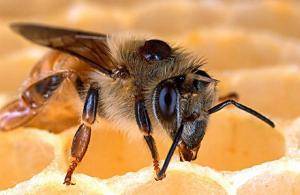It is a hard thing to explain and an even harder thing to imagine. The disappearance of millions of honey bees across the United States with no tangible explanation and no dead bees left behind to examine. Bees are simply vanishing. But before you declare a spiteful “good riddance” from all those stings or embarrassing situations where you run and bend and swat to flee from this relatively harmless insect, first stop and think of the global implications of a world without its natural pollinators.
The Importance of Our Natural Pollinators
As a paramount force in our ecosystems, honey bees act as a vessel for plant reproduction.1 Without bees, many plants would simply cease to exist.2 Albeit man’s continual advancements, homosapiens have failed to find a viable replacement for bees, despite numerous attempts to, such as dropping chemically-enhanced pollen by helicopters.3 Bees are crucial to money making crops like avocados, kiwis, and almonds, and as a result, bees add up to15 million dollars of total U.S. crop value. One out of three bites of our daily diet is bee-dependent.4 And if you aren’t yet convinced, even Albert Einstein believed the apocalypse caused by bee extinction through his famous prediction: “If the bee disappeared off the surface of the globe, then man would only have four years of life left.” 5
The Suspects of Colony Collapse Disorder
This inexplicable evanescence of bees has been named “Colony Collapse Disorder” (CDC) and has been reported in nearly half of the states in the U.S. On the west coast, 30-60% of bees are being lost, the majority in California where crops like almonds are 100% dependent on bees for reproduction. Bee keepers, who feed and look after bees in portable metal boxes, are becoming increasingly worried and vocal about the mystery of containers that are one day full of bees and the next day are totally empty. CDC isn’t just happening in the U.S. either, all across the world from France to the Middle East, countries are experiencing the same phenomenon.6 The situation in North America is particularly dire, as in this continent up to 90% of the wild bees have gone missing in the most recent years.7 So what is the cause? Scientists are not sure, but they do have a few suspects:
Disease: Pathogens are always a good guess when unknown epidemics sweep through hearty populations of creatures. Scientists are currently looking more into the Varroa mite, a notorious parasite of worker and drone honey bees. Female mites lay their eggs within the cells of a bee pupa. When the eggs hatch, the baby mites feed on the bee pupa until the bee fully develops and emerges as a bee, or until the mites eat the pupa entirely. These parasites can be transported hive to hive via bee. If not treated by its bee keeper, hives will die within 1-2 years from mite infection.8

The black dot on the bee’s back is a Varroa mite, picture courtesy of
http://www.sciencedaily.com/releases/2008/06/080629191259.htm.
Another possible subject for the bees’ demise is the Deformed Wing Virus (DWV), a disease carried by Varroa mites. Although researchers were convinced that DWV reproduced within the mite, that theory has been disproved, suggesting that the mites simply eat the virus. But mites cannot vomit, meaning once eaten, the virus cannot be transmitted to bees. Basically, there is a great deal to find out about the mites, pathways, and the virus itself, before the virus can be blamed for the bees. 9
Another culprit is the single-celled protozoa Nosema, yet nothing is conclusive regarding this potential theory either.10 Further adding to the chaos is that scientists and bee keepers are not convinced that a pathogen is responsible. After all, the evidence of disease typically includes the remains of what was once alive, and with this epidemic the only evidence is in the form of empty boxes and hives.
Stress: Stress may not sound reasonable enough to spawn a deadly epidemic, but stress weakens the immune system and may cause a disturbance in bees’ social network, which they are entirely dependent upon.11 Bees may suffer stress for an array of reasons. First, they are driven in trucks like cattle across the country to be used solely for their role in ecosystems. Second, because bees are expected to go forth and pollinate when told to, bees are expected to do their job a longer time out of the year then they are naturally designed to, meaning they may be given more work by bee keepers than they can physically handle. Bees are more active in spring and summer, but for the almond business, pollination needs to start in February.12 Humans definitely have bees working overtime.
Pesticides: The effects of poisonous chemicals on bees are not yet proven, but there is a theory that these insecticides cause bees to become disoriented so they are not able to find their way back home.13 Although there is much speculation, the effects of pesticides are not often known until decades later, and pesticides are not always overtly blamed for the massive amount of havoc many believe they wreck on entire ecosystems.
Genetically Engineered Crops: Another possibility is that genetically modified crops are toxic to pollinators, which could explain why it has been so difficult to find a reason behind the bees’ deaths: the crops themselves are killing their pollinators. Poisons could also come from chemicals directly applied to hives that is used to kill mites, or those sprayed straight onto the crops.14 The DNA of these plants contains poisons such that they can be resistant to pests—like beetles, mosquitoes, and flies—without the need to use external sprays, i.e. pesticides. Consumers are constantly reassured that engineered food is okay, but for bees it could be a different story.
For more on genetically modified crops, see the Greeniacs Article “Genetically Modified Organisms The Debate”.
Steps Being Taken For Now

In parts of the US, farmers have instituted a “no fly zone” for bees, to keep bees from aiding reproduction for the wrong type of species—such as pollinating a variety of seedless oranges, instead of oranges with seeds. The New York Times reports that bee keepers often need to plea with landowners to release bees onto farmers’ lands so the bees can feed and pollinate.15 This is a highly ironic situation. Farmers are denying these creatures their natural right in their natural lands even as bees continue to die off thus endangering farming as an institution. From an environmental perspective, we need to do something to protect this creature that plays such a large and instrumental role in all of our lives, whether we know it or not. Shipping bees from coast to coast seems unnecessary and ecologically unethical. Beekeepers and farmers—whose industries are co-dependent—need to work hand in hand to ensure the survival of this crucial creature.





